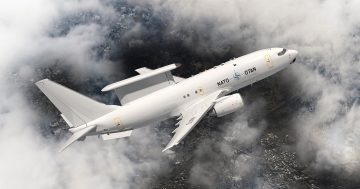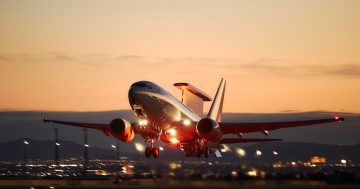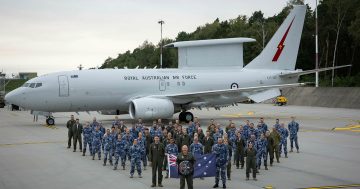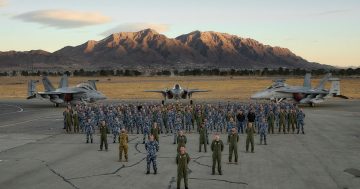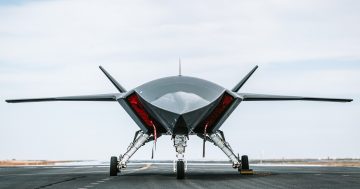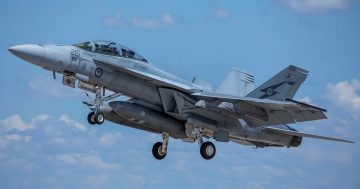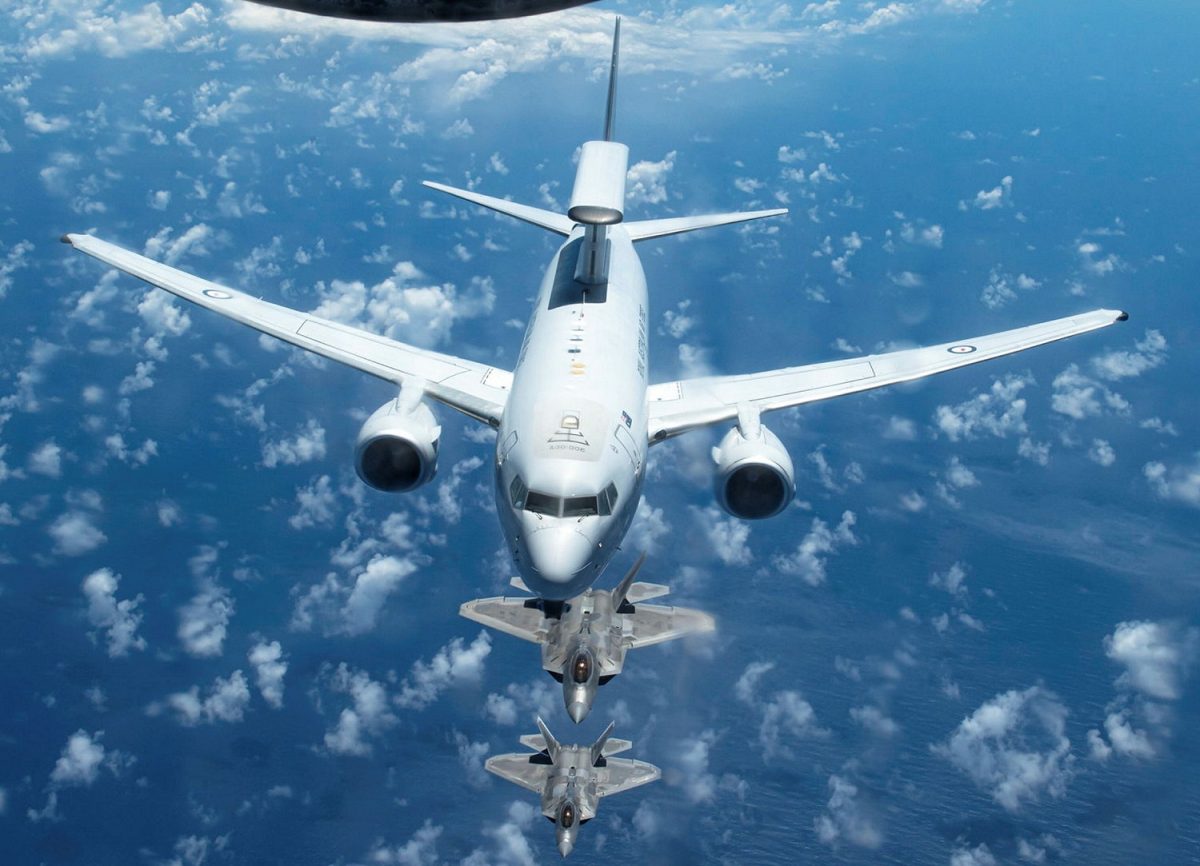
An RAAF E-7A Wedgetail flies with US Air Force F-22 fighters near Hawaii in 2021. Photo: ADF.
The chiefs of the UK’s Royal Air Force, the United States Air Force and the Royal Australian Air Force met on the sidelines of last week’s Royal International Air Tattoo air show in the UK to sign an agreement on the development of the Wedgetail airborne early warning and control (AEW&C) aircraft.
The Boeing E-7A Wedgetail is the world’s foremost AEW&C aircraft. Based on a commercial Boeing 737-700 airframe, it features a large and distinctive “surfboard” radar on its rear fuselage as well as several other modifications.
Australia was the first customer for the Wedgetail through its Project AIR 5077 requirement. After a delay of several years due to developmental issues, the first of six aircraft entered RAAF service in 2010, with Turkey and South Korea following soon after with four E-7s each.
Since the RAAF’s Wedgetail entered service and began deploying to the Middle East and major exercises around the world, the UK and US have been able to see its capabilities first-hand, and both countries have now ordered it themselves. The UK and US have also sent their own crews to Australia to train or for exchange postings on the E-7A, and are taking the knowledge gained back home to help establish their own Wedgetail capabilities.
The trilateral joint vision agreement signed by the three nations is a commitment to work together on Wedgetail capability development, evaluation and testing, interoperability, sustainment, operations, training, and safety.

(L-R) USAF Chief General C Q Brown, RAAF Chief AIRMSHL Rob Chipman, and RAF Chief Air Chief Marshal Sir Rich Knighton sign the E-7 collaborative agreement at RIAT. Photo: UK MoD.
“The signing of this Joint Vision Statement by our three Air Forces is an exciting opportunity that will allow us to work collaboratively to develop our Wedgetail fleets to ensure that they remain ready to provide airborne early warning and control as the threats and challenges we face change,” Air Chief Marshal Sir Rich Knighton, Royal Air Force Chief of the Air Staff said.
As the E-7’s radar, electronic support measures, computers, displays, and other systems are largely digital, the aircraft is far easier to upgrade than previous generations of command and control aircraft. A common upgrade path between the AUKUS partners will allow for more capabilities to be developed, a common configuration to be established, and those development costs to be shared across a fleet of more than 35 aircraft.
Upgrades will continue to be rolled out through the life of the aircraft as new threats emerge and new capabilities to counter those threats are developed.
Chief of Staff of the US Air Force General Charles Q Brown said, “Collaboration and interoperability are critical to our warfighting advantage, signing this joint vision statement represents another step in the long-term, enduring commitment we have to the future and to the security of our three countries.
“The relationship between the United Kingdom, Australia and the United States is more robust than ever, and we share a mutual understanding of the challenges we face in the air domain and the need to address them.
RAAF Chief Air Marshal Robert Chipman added, “This Joint Vision Statement is a testament to the close relationship shared historically by our three Air Forces. I look forward to continuing our joint interests in this versatile and impressive capability.”
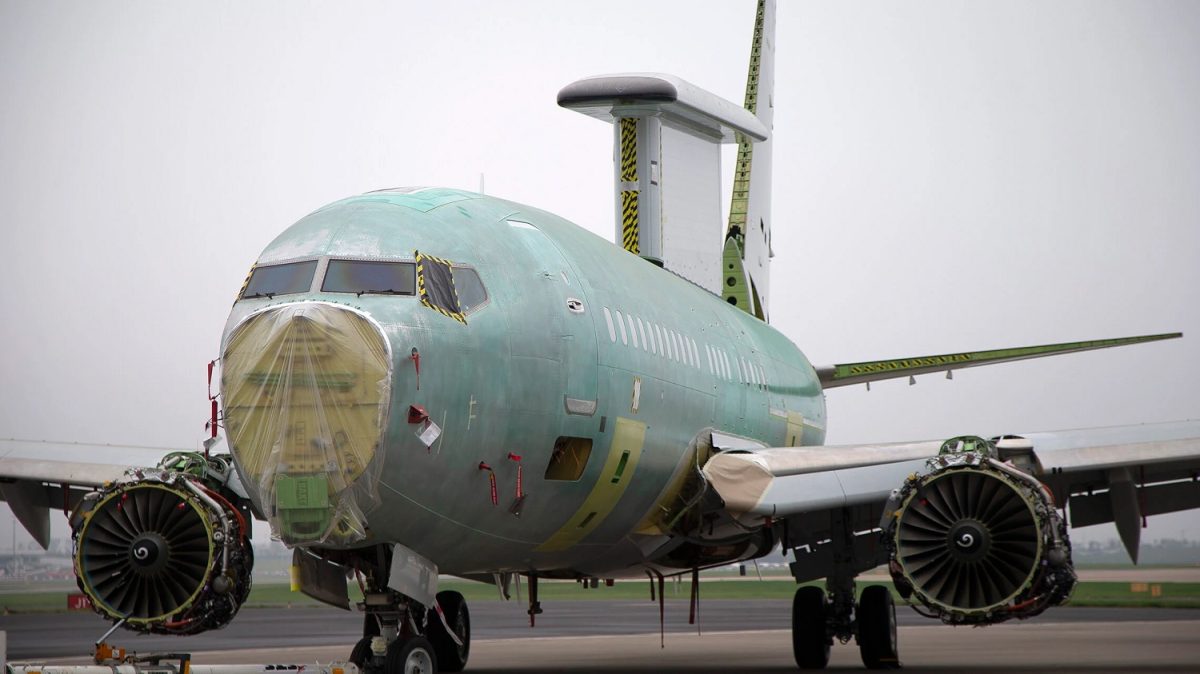
A UK E-7 undergoing modification work in Birmingham. Photo: UK MoD
The UK RAF has to date ordered three Wedgetails to replace its Boeing E-3D Sentry aircraft which were retired last year. The new aircraft are currently being modified in Birmingham and are expected to enter service in 2025. It has also ordered two extra Northrop Grumman Multi-role Electronically Scanned Arrays (MESA), the E-7’s primary sensor, so it is expected the UK may order an additional two aircraft.
The US Air Force has a requirement for 26 E-7s, and announced in March that funding had been allocated to its first two development and test aircraft. It will replace its own fleet of 1970s-vintage E-3A/C AWACS.
The E-7’s MESA radar has hundreds of individual nodes that allow it to observe 360 degrees of airspace at the same time, while ‘staring’ in detail at a particular quadrant if necessary. The E-3’s older APY radar has a 10-metre diameter rotating radome on its upper fuselage that takes 10 seconds to fully rotate and complete a sweep of the skies. The 737-700 upon which the E-7 is based is also newer, much smaller, and far more efficient than the E-3’s 707 host airframe, which was designed in the 1950s.
The RAAF recently announced it would deploy one of its Wedgetails to Germany for a six-month period to conduct command and control missions in the skies over Eastern Europe as part of NATO’s support for Ukraine against Russia’s invasion.
Original Article published by Andrew McLaughlin on Riotact.



